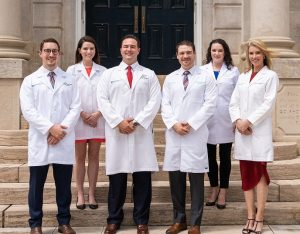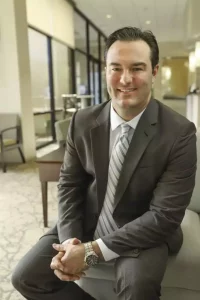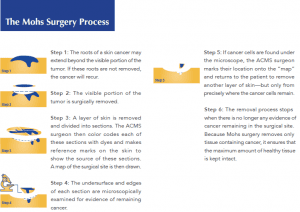What is Mohs Surgery?
 Now that you have been diagnosed with skin cancer and are looking for skin cancer treatment, you are most likely starting research into options. You are probably hearing about Mohs Surgery and the importance of finding a Fellowship-trained Mohs Surgeon.
Now that you have been diagnosed with skin cancer and are looking for skin cancer treatment, you are most likely starting research into options. You are probably hearing about Mohs Surgery and the importance of finding a Fellowship-trained Mohs Surgeon.
Other questions you might be asking are:
Am I in serious danger? How did this happen? What treatment options do I have?
You are not alone. One in five Americans will develop skin cancer by the age of 70. In the United States, more than 3 million people are diagnosed with skin cancer each year; most will likely have these same questions. It is crucial to be an active participant in your treatment and when considering your options, it is important to recognize a skin cancer that is visible to you — or even the physician — may just be the tip of the iceberg.
 In deciding on skin cancer treatment, you should understand that:
In deciding on skin cancer treatment, you should understand that:
-
- Not all cancer cells are apparent to the naked eye.
- Many “invisible” cells may form roots of diseased tissue that can extend beyond the boundaries of a visible cancer.
- If all of the cancer cells are not completely removed, the cancer will regrow and must be removed again.
Dr. Henry and our Providers can help you decide which skin cancer treatment is best for your particular diagnosis. Various treatments for skin cancer include scraping and burning, routine excision, radiation, and in some cases, the use of a cream. While these remedies might be effective in some cancers, they have a higher potential of leaving cancerous cells behind, making it necessary for the lesions to be removed again. In fact, these other treatment modalities have a 10 to 15 times higher rate of recurrence when compared to Mohs surgery.
 What is Mohs Surgery?
What is Mohs Surgery?
Mohs micrographic surgery is a skin cancer treatment that removes all of the cancer, minimizes the risk of recurrence, and leaves as little scarring as possible.
Mohs is the most effective treatment for most types of cancer to date with a cure rate of up to 99% for skin cancer.
By removing the smallest amount of healthy tissue, it also offers superior cosmetic results.
Fellowship-trained American College of Mohs Surgery surgeons, like Dr. Henry, have extensive training in reconstructive surgery and are generally able to perform the reconstructive surgery immediately after microscopic analysis confirms the cancer has been completely removed, saving you time, money, and hassle.
Mohs Surgery: The Most Effective Treatment for Skin Cancer
Cirugía de Mohs: el tratamiento más eficaz para el cáncer de piel
Mohs Surgery Skin Cancer Treatment
Mohs micrographic surgery is a process that removes all of cancer, minimizes the risk of recurrence, and leaves as little scarring as possible. Mohs is the most effective treatment for most types of cancer to date with a cure rate of up to 99% for skin cancer.
While any board-certified dermatologist may perform Mohs surgery, only members of the American College of Mohs Surgery (ACMS) have undergone rigorous fellowship training. Chosen through an extremely competitive review and selection process, fellows are required to complete an intensive 1 or 2-year post-residency ACMS fellowship training program. This extensive training includes participation in at least 500 Mohs surgery cases under the supervision of an experienced ACMS-approved Mohs surgeon. We are extremely fortunate that our own Dr. Henry is a Fellowship-trained Mohs surgeon, the best of the best, and one of the only Fellowship-trained Mohs Surgeons in our region. For more details on the Fellowship Difference, please click HERE.
Mohs Surgery – What to Expect
Our Mohs micrographic surgeries are performed in our comfortable, state-of-the-art surgical suite on an outpatient basis with local anesthetic. We have a team of expert nurses, scrub techs, lab technicians, and medical assistants ready to care for you during every aspect of your treatment. Most of our staff have been with our clinics for years.
Because the procedure does take a few hours, depending on the complexity and size, we encourage patients to bring a book, crossword puzzle, etc. We have WIFI and a coffee bar, but do encourage you to bring snacks and drinks to make yourself as comfortable as possible during your treatment.
The Surgery
 Mohs surgery is performed in stages. During the first stage, the area is numbed with a local anesthetic, then the surgeon removes only the visible tumor with a small margin of healthy appearing tissue. A temporary pressure bandage will be placed on the wound, and the patient will be escorted to a private surgical waiting area.
Mohs surgery is performed in stages. During the first stage, the area is numbed with a local anesthetic, then the surgeon removes only the visible tumor with a small margin of healthy appearing tissue. A temporary pressure bandage will be placed on the wound, and the patient will be escorted to a private surgical waiting area.
Ensuring all the cancer is removed – Why Mohs Surgery is the Gold Standard
Meanwhile, the physician will prepare the tissue for examination under the microscope to determine if any of the tumor remains. This process usually takes anywhere from one to two hours. If there is remaining tumor, the exact location of that remaining cancerous tissue is marked. The Mohs procedure is repeated until there is no cancerous tissue left on the affected area. By treating the tumor this way, the microscopic roots are made visible and can be removed in a conservative manner, preserving as much normal tissue as possible. For details on the steps, please visit HERE.
The Repair
After the surgeon is confident all of the cancer has been removed, the last process begins where the patient and doctor, together, will determine how the wound will be repaired. In addition to advanced training in the removal of skin cancer, fellowship-trained Mohs College surgeons also have specialized reconstructive surgery training for repairing the wound. This makes for cost-efficient and effective treatment for skin cancer removals.

